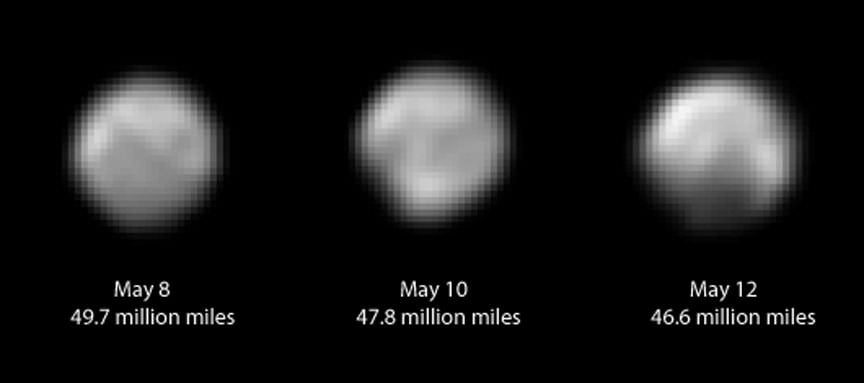Hey Pluto, it's great to see your face! Since sending its last batch of images in April, NASA's
probe lopped off another 20 million miles in its journey to the mysterious world. Among the latest revelations: the dwarf planet displays a much more varied surface and the bright polar cap discovered earlier this spring appears even bigger.
[caption id="attachment_120532" align="aligncenter" width="580"]
Comparison of the April image of one hemisphere of Pluto with the same hemisphere photographed in May. The photos have been rotated to align Pluto's rotational axis with the vertical direction (up-down), as shown schematically in the center panel. Between April and May, Pluto grew larger as the spacecraft got closer, with Pluto's apparent size increasing by approximately 50%. Pluto rotates around its axis every 6.4 Earth days; this and the images below show the variations in Pluto's surface features during its rotation. Credit: NASA[/caption]
"These new images show us that Pluto's differing faces are each distinct; likely hinting at what may be very complex surface geology or variations in surface composition from place to place," said New Horizons Principal Investigator Alan Stern, of the Southwest Research Institute in Boulder, Colorado.
[caption id="attachment_120531" align="aligncenter" width="580"]
Compare Pluto's polar cap (white spot at top of the globe), first seen in April (left) with the latest image taken on May 10. Approximately the same face of Pluto is shown in both images. The cap's extent varies with longitude. Credit: NASA[/caption]
Mission scientists caution against over-interpreting some of the smaller details. The photos have been processed using a method called
deconvolution
, which strips away the out-of-focus information to enhance features on Pluto. Deconvolution can occasionally add "false" details or artifacts, so the smallest features in these pictures will need to be confirmed by images taken from closer range in the next few weeks.
[caption id="attachment_120535" align="aligncenter" width="580"]
Pluto compared on April 16, 2015 and May 12. Credit: NASA[/caption]
Compared to recent photos of
, the other dwarf planet in the limelight this season, Pluto shows only light and dark blotches. That's how Ceres started out too. All those variations in tone and texture suggest a fascinating and complex surface. And it's clear that the polar cap — whatever it might ultimately be — is extensive and multi-textured. The images were taken from a little less than 50 million miles (77 million km) away or about the same distance Mars is from Earth during a typical opposition.
[caption id="attachment_120533" align="aligncenter" width="580"]
New Horizons current position and particulars on May 28, 2015. Credit: NASA[/caption]
Watch for dramatic improvements in the images as New Horizons speeds toward its target, covering 750,000 miles per day until closest approach on July 14. By late June, they'll have four times the resolution; during the flyby that will improve to 5,000 times. The spacecraft is currently 2.95 billion miles from Earth. Light, traveling at 186,00o miles per second, requires 8 hours and 47 minutes - the length of a typical work day - to make the long round trip.
 Universe Today
Universe Today
